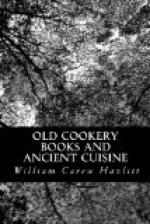Those who desire to be more amply informed of the domestic economy of the ancient court, and to study the minutiae, into which I am precluded from entering, can easily gratify themselves in the pages of “The Ordinances and Regulations for the Government of the Royal Household,” 1790; “The Northumberland Household Book;” and the various printed volumes of “Privy Purse Expenses” of royal and great personages, including “The Household Roll of Bishop Swinfield (1289-90).”
The late Mr. Green, in his “History of the English People” (1880-3, 4 vols. 8vo), does not seem to have concerned himself about the kitchens or gardens of the nation which he undertook to describe. Yet, what conspicuous elements these have been in our social and domestic progress, and what civilising factors!
To a proper and accurate appreciation of the cookery of ancient times among ourselves, a knowledge of its condition in other more or less neighbouring countries, and of the surrounding influences and conditions which marked the dawn of the art in England, and its slow transition to a luxurious excess, would be in strictness necessary; but I am tempted to refer the reader to an admirable series of papers which appeared on this subject in Barker’s “Domestic Architecture,” and were collected in 1861, under the title of “Our English Home: its Early History and Progress.” In this little volume the author, who does not give his name, has drawn together in a succinct compass the collateral information which will help to render the following pages more luminous and interesting. An essay might be written on the appointments of the table only, their introduction, development, and multiplication.
The history and antiquities of the Culinary Art among the Greeks are handled with his usual care and skill by M.J.A. St. John in his “Manners and Customs of Ancient Greece,” 1842; and in the Biblia or Hebrew Scriptures we get an indirect insight into the method of cooking from the forms of sacrifice.
The earliest legend which remains to us of Hellenic gastronomy is associated with cannibalism. It is the story of Pelops—an episode almost pre-Homeric, where a certain rudimentary knowledge of dressing flesh, and even of disguising its real nature, is implied in the tale, as it descends to us; and the next in order of times is perhaps the familiar passage in the Odyssey, recounting the adventures of Odysseus and his companions in the cave of Polyphemus. Here, again, we are introduced to a rude society of cave-dwellers, who eat human flesh, if not as an habitual diet, yet not only without reluctance, but with relish and enjoyment.




